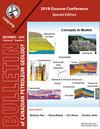Discovery of organic-rich black shale xenolith from kimberlite on the Hall Peninsula, Nunavut and its implication for petroleum potential in Cumberland Sound
Q3 Earth and Planetary Sciences
引用次数: 4
Abstract
The Chidliak kimberlite province covers an area of 40 × 70 km on the eastern Hall Peninsula, southeastern Baffin Island, Nunavut, between Frobisher Bay and the Cumberland Sound (Fig. 1). The eastern Hall Peninsula is an Archean gneissic terrain, into which all the Late Jurassic–Early Cretaceous aged kimberlites (156.7–139.1 Ma; Heaman et al., 2012) intruded. At present, there is no consolidated Phanerozoic sedimentary cover on the Hall Peninsula; however, a great number of sedimentary rock xenoliths yielding conodont microfossils were entrained by the kimberlites. These xenoliths suggest that Upper Ordovician and Lower Silurian strata with a total thickness about 270–305 m were present on the Hall Peninsula at least until Early Cretaceous time (Zhang and Pell, 2013; 2014). Figure 1 A). Simplified geologic map of the Foxe Basin and vicinity (modified from Wheeler et al., 1997), showing the location of the Chidliak project area (red polygon), the drill hole CHI-482-10-DD01 with the black shale xenolith (red star), suspect natural hydrocarbon seep (yellow dots; location data from Budkewitsch et al., 2013) and Paleozoic (black cross) and Mesozoic (red cross) cores collected by shallow drillings during 1970s and 1980s (location data from Zhang, 2013a). B). Enlargement of the area enclosed by black rectangle in (A). Cumberland Sound, to the northeast, is partially underlain by Cretaceous clastic and Paleozoic carbonate sedimentary rocks (Fig. 1; MacLean et al., 1986). On the sea surface of Cumberland Sound, 28 suspect natural hydrocarbon seep occurrences were identified (Fig. 1; Budkewitsch et al., 2013), indicating an active petroleum system may occur in the sound; however, the source rocks remain uncertain. A rare black shale xenolith (Fig. 2A) was discovered from a kimberlite on the Hall Peninsula. Given the geologic and geographic position of the peninsula, it provides valuable evidence about the possible existence of an active …努纳武特霍尔半岛金伯利岩富有机质黑色页岩捕虏体的发现及其对坎伯兰湾油气潜力的指示意义
Chidliak金伯利岩省位于努纳武特巴芬岛东南部的霍尔半岛东部,位于Frobisher湾和Cumberland海峡之间,面积为40 × 70 km(图1)。霍尔半岛东部为太古宙片麻岩地,其中所有的晚侏罗世-早白垩世金伯利岩(156.7-139.1 Ma;Heaman et al., 2012)入侵。霍尔半岛目前没有显生宙固结盖层;然而,大量产牙形石微化石的沉积岩包体被金伯利岩夹带。这些捕虏体表明,至少在早白垩世之前,霍尔半岛上存在总厚度约270 ~ 305 m的上奥陶统和下志留统地层(Zhang and Pell, 2013;2014)。图1 A) Foxe盆地及周边地区简化地质图(修改自Wheeler et al., 1997),显示Chidliak项目区位置(红色多边形)、CHI-482-10-DD01钻孔及黑色页岩包体位置(红色星形)、疑似天然烃渗漏位置(黄色圆点;Budkewitsch等人,2013)和70年代和80年代浅层钻井收集的古生代(黑叉)和中生代(红叉)岩心的位置数据(位置数据来自Zhang, 2013)。(B). (A)中黑色矩形包围区域的扩大。东北方向的cumberland Sound部分被白垩纪碎屑岩和古生代碳酸盐岩沉积岩所覆盖(图1;MacLean et al., 1986)。在Cumberland Sound海面上,确定了28处疑似天然烃渗漏点(图1;Budkewitsch et al., 2013),表明声音中可能存在活跃的含油气系统;然而,烃源岩仍不确定。在霍尔半岛的金伯利岩中发现了一种罕见的黑色页岩捕虏体(图2A)。考虑到半岛的地质和地理位置,它为可能存在一个活跃的…
本文章由计算机程序翻译,如有差异,请以英文原文为准。
求助全文
约1分钟内获得全文
求助全文
来源期刊

Bullentin of Canadian Petroleum Geology
Earth and Planetary Sciences-Geochemistry and Petrology
CiteScore
2.50
自引率
0.00%
发文量
0
期刊介绍:
The Bulletin of Canadian Petroleum Geology is a peer-reviewed scientific journal published four times a year. Founded in 1953, the BCPG aims to be the journal of record for papers dealing with all aspects of petroleum geology, broadly conceived, with a particularly (though not exclusively) Canadian focus. International submissions are encouraged, especially where a connection can be made to Canadian examples.
 求助内容:
求助内容: 应助结果提醒方式:
应助结果提醒方式:


